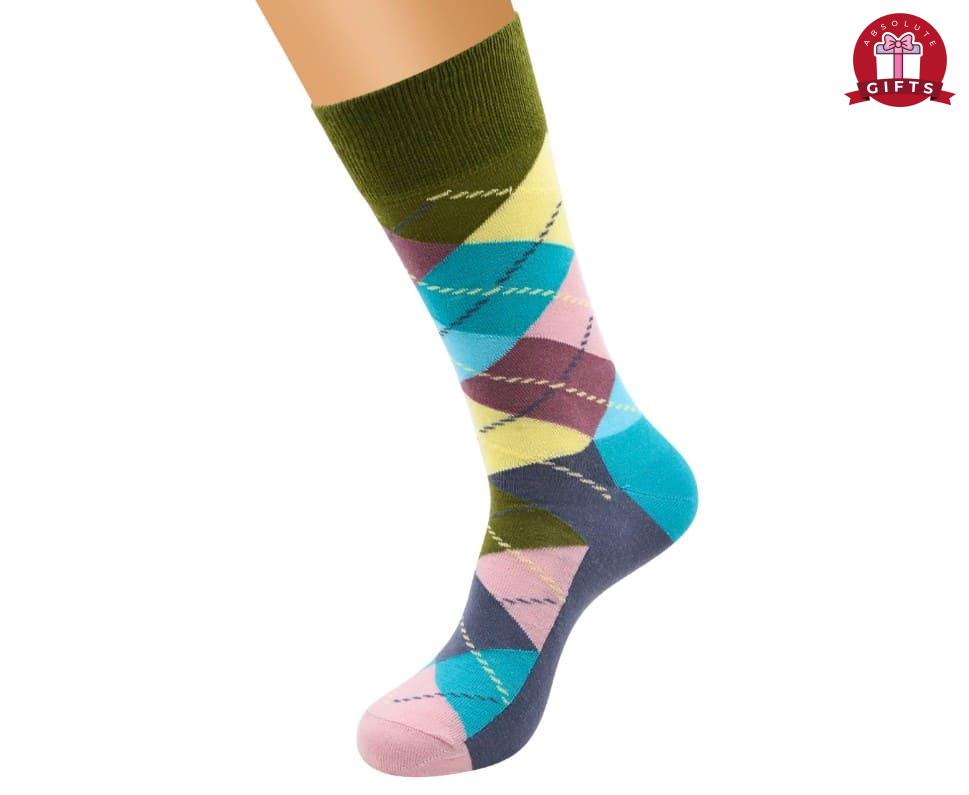Blog
Combed Cotton Socks: How They Compare to Regular Cotton in Softness?
When it comes to choosing the right socks for your daily comfort and style, not all materials are created equal. Enter combed cotton socks, a premium choice that stands out from regular cotton and other types of socks on the market. Known for their softness, breathability, and high-quality, combed cotton socks offer a blend of comfort and elegance that elevates your wardrobe while ensuring your feet stay comfortable throughout the day. Their natural fiber construction also provides moisture-wicking and absorbent properties, making them a go-to option for those who value both luxury and practicality in their sock selection.

This article will delve into the world of combed cotton socks, comparing them to regular cotton socks and other materials like polyester socks to highlight their cooling, resistant, and breathable qualities. You’ll discover why these socks are not just about premium cotton; they’re about enhancing your everyday comfort with a product that’s soft, absorbent, and designed to last. From exploring what makes combed cotton a high-quality choice to understanding the benefits that make them worth the investment, you’ll find all the information you need to make an informed decision about which socks can best meet your needs. Whether you’re looking for the ultimate in foot comfort or seeking a resistant and durable option for your active lifestyle, comed cotton socks stand out as a superior choice.
-
 Argyle Yellow Printed Quality Combed Cotton Socks£7.99
Argyle Yellow Printed Quality Combed Cotton Socks£7.99 -
 Argyle Brown Printed Quality Combed Cotton Socks£7.99
Argyle Brown Printed Quality Combed Cotton Socks£7.99 -
 Argyle Multi colour Printed Quality Combed Cotton Socks£7.99
Argyle Multi colour Printed Quality Combed Cotton Socks£7.99 -
 Argyle Pastel Printed Quality Combed Cotton Socks£7.99
Argyle Pastel Printed Quality Combed Cotton Socks£7.99 -
 Argyle Blue Printed Quality Combed Cotton Socks£7.99
Argyle Blue Printed Quality Combed Cotton Socks£7.99 -
 Andy Warhol Daisy Printed Quality Combed Cotton Socks£7.99
Andy Warhol Daisy Printed Quality Combed Cotton Socks£7.99 -
 Andy Warhol Daisy Printed Quality Combed Cotton Socks£7.99
Andy Warhol Daisy Printed Quality Combed Cotton Socks£7.99
What is Cotton?
Cotton, a staple in the textile industry, is a natural material that grows in the seedpod of the cotton plant, known as the boll. This plant thrives in warmer climates across over 80 countries, benefiting greatly from sunny conditions without frost. The boll, about the size of a golf ball, contains multiple seeds, each surrounded by soft, fluffy fibers.
Basic Characteristics
Cotton fibers are predominantly composed of cellulose, an organic compound that constitutes the structure of most plants. Each boll can house up to 150,000 fibers, which are later harvested, cleaned, and spun into yarn. This yarn is then woven into the durable, soft fabric widely used today. Notably, cotton is not only comfortable but also boasts high absorbency, breathability, and strength, which increases when wet.
Types of Cotton
There are several types of cotton, each with unique properties:
- Gossypium hirsutum: This is the most common type, making up about 90% of worldwide production. It’s appreciated for its general use in a wide range of textile products.
- Gossypium barbadense: Known for its extra-long staple fibers, this type is softer and more luxurious, used in high-end products.
- Gossypium arboreum and Gossypium herbaceum: These less common types are known for specific uses in certain geographic and cultural contexts.
Advantages of Cotton
Cotton’s benefits are numerous, making it a favored choice for various applications:
- Comfort and Breathability: Its natural softness and the ability to wick moisture help keep the skin dry and comfortable.
- Durability and Maintenance: Cotton is strong, withstands high temperatures during washing, and is relatively easy to care for.
- Hypoallergenic Properties: Ideal for sensitive skin, cotton reduces the risk of allergic reactions.
- Environmental Impact: Organic cotton options offer a sustainable choice, minimizing pesticide use and reducing environmental footprint.
Incorporating these characteristics, cotton stands out not only for its practical benefits but also for its role in sustainable fashion and consumer products. As you consider the various types of socks available, understanding these fundamental aspects of cotton can guide you in making informed choices that align with your needs and values.
What is Combed Cotton?
Combed cotton is a refined version of cotton that has undergone additional processing to ensure higher quality and durability. This process involves treating the cotton fibers before they are spun into yarn, enhancing the fabric’s overall softness and strength. Absolute Gifts is selling the best quality combed cotton socks.
The combing process is meticulous and aimed at creating a superior textile product. Initially, cotton fibers are carded to align them and remove debris. Following this, the fibers are passed through fine combs that remove shorter fibers and impurities, which can compromise the fabric’s texture and durability. This results in longer, straighter cotton fibers that are more uniform in length and alignment. These enhanced fibers are then spun into yarn, which is not only smoother and stronger but also more lustrous and less likely to pill.
Advantages of Combed Cotton
Combed cotton offers several benefits that make it a premium choice for various textiles:
- Softness: The removal of short fibers results in a smoother fabric that feels soft against the skin.
- Strength and Durability: Longer fibers increase the fabric’s strength, making it more durable and resistant to wear and tear.
- Breathability: The alignment of the fibers enhances the fabric’s breathability, keeping you cool and comfortable.
- Absorbency: High absorbency makes it ideal for towels and other products where moisture management is crucial.
- Less Pilling: The fiber alignment and removal of short fibers reduce the likelihood of pilling, maintaining the fabric’s aesthetic appeal over time.
Applications of Combed Cotton
Combed cotton is versatile and finds applications across a wide range of products, enhancing the user’s experience through its superior qualities. It is extensively used in:
- Clothing: Particularly in making t-shirts, dresses, and undergarments where comfort and softness are paramount.
- Bed Linens: Its soft texture and strength make it ideal for bed sheets and pillowcases that offer a luxurious feel.
- Towels: Known for its absorbency and softness, making it a popular choice for bath and hand towels.
This cotton variant, by virtue of its processing and resultant properties, stands out as a preferred material for those seeking quality and comfort in their textiles.
Comparing Regular Cotton Socks and Combed Cotton Socks
Softness and Texture
When you choose your socks, the feel against your skin is crucial. Regular cotton socks are known for their softness and comfort, making them a popular choice for everyday wear. However, combed cotton socks take softness to another level. The process of combing removes short fibers, which are prone to fraying and breaking, resulting in a smoother and more luxurious texture. This makes combed cotton socks not only softer but also provides a more premium feel to your skin.
Durability
Durability is a significant factor in selecting socks. Regular cotton socks offer decent durability and are suitable for daily use. On the other hand, combed cotton’s long fibers enhance the fabric’s strength, making these socks more resistant to wear and tear. The combing process aligns the fibers better, which significantly reduces the likelihood of pilling and extends the lifespan of the socks.
Absorbency and Breathability
Both types of cotton are naturally absorbent, but combed cotton socks excel in moisture management due to their high absorbency and breathability. This characteristic is particularly beneficial in maintaining comfort and preventing odors when you’re active or in warmer climates. Additionally, the hypoallergenic properties of combed cotton make it an excellent choice for those with sensitive skin, as it reduces the risk of irritation and allergies.
- Comparison of Regular and Combed Cotton Socks:
- Softness: Combed cotton is silkier and softer due to the removal of shorter fibers.
- Durability: Enhanced by longer fibers, combed cotton socks are more durable and less prone to pilling.
- Breathability: The alignment of fibers in combed cotton improves air circulation, keeping your feet cool and dry.
- Pros and Cons of cotton and combed cotton socks:
- Regular Cotton Socks:
- Pros: Affordable, soft, and comfortable.
- Cons: Less durable, prone to pilling, retains moisture.
- Combed Cotton Socks:
- Pros: Superior softness, high durability, excellent moisture management.
- Cons: Generally more expensive than regular cotton socks.
- Regular Cotton Socks:
By understanding these differences, you can make a more informed choice about which socks best meet your needs, ensuring both comfort and durability in your daily activities.
Why Choose Combed Cotton Socks?
Benefits for Daily Wear
Combed cotton socks are not just a treat for your feet; they’re a smart choice for daily wear. The unique process of combing makes these socks exceptionally soft, enhancing your comfort every step of the way. This softness is due to the removal of short fibers, which also reduces the likelihood of irritation, making them ideal for those with sensitive skin. Moreover, the strength and durability provided by the longer fibers mean that your socks can withstand the daily rigors of wear and tear, ensuring that they last longer and provide consistent comfort.
Ideal Conditions for Use
Whether you’re braving the cold or enjoying milder weather, combed cotton socks are suitable for a wide range of temperatures. They are perfect for year-round use, keeping your feet warm in the winter and cool in the summer thanks to their breathable fibers. This adaptability makes combed cotton socks a versatile addition to your wardrobe, capable of providing comfort in temperatures ranging from 0°C (32°F) to 28°C (82°F).
Environmental Impact
Choosing combed cotton socks also means making a positive impact on the environment. Organic combed cotton is grown using methods that have a lower negative impact on the earth. These methods help preserve soil fertility and reduce water consumption, making them a more sustainable choice. By opting for combed cotton, you’re not only choosing quality and comfort but also contributing to more sustainable farming practices.
- Comparison of Environmental Impact:
- Regular Cotton: High water and chemical use, contributing to soil and water pollution.
- Combed Cotton: Uses less water and chemicals, supporting sustainable agriculture.
- Pros and Cons:
- Pros: Sustainable, soft, durable, suitable for sensitive skin, adaptable to various temperatures.
- Cons: May be more expensive than regular cotton options, but the benefits justify the cost.
By understanding these key aspects, you can make an informed decision that aligns with both your comfort needs and environmental values.
Conclusion
Exploring the myriad benefits and distinguishing features of combed cotton socks over regular cotton counterparts reveals a clear preference for the former in terms of softness, durability, breathability, and moisture management. The meticulous combing process not only ensures the elimination of short fibers, leading to a superior soft touch and feel but also enhances the fabric’s strength and durability. This makes combed cotton socks an ideal choice for anyone looking for a blend of luxury, comfort, and longevity in their daily wear. Furthermore, the environmental benefits associated with the production of organic combed cotton highlight an additional layer of value, marrying sustainability with superior quality.
Choosing combed cotton socks means investing in exceptional foot comfort and contributing positively to environmental sustainability. Their versatility across different climates and suitability for sensitive skin makes them a superior addition to one’s wardrobe. As you consider upgrading your sock collection or choosing a thoughtful gift, remember the unparalleled benefits of combed cotton. Get the best quality socks that ensure your feet are wrapped in comfort and style throughout the seasons. Whether for daily use or special occasions, these socks stand out as a testament to what meticulous manufacturing and attention to detail can achieve in everyday apparel.
FAQs
How does the softness of combed cotton compare to regular cotton?
Combed cotton is notably softer than regular cotton. This softness is achieved by an additional treatment process after the cotton is harvested and spun into yarn. During this process, many impurities are removed, making combed cotton smoother and more resistant to pilling than regular cotton.
Why is combed cotton considered suitable for socks?
Combed cotton is ideal for socks due to its premium quality and silky texture. It features long fibers that intertwine effectively, enhancing the softness, durability, and washability of the socks. Key attributes of combed cotton include its softness, breathability, absorbency, freshness, durability, hypoallergenic properties, and ease of care.
Is combed cotton purely made from cotton?
Yes, combed cotton is made entirely from 100% cotton fibers. The combing process is used to remove impurities and short fibers, ensuring that only the longest and strongest fibers remain. This process enhances the quality and feel of the cotton.
What is the texture of combed cotton like?
Combed cotton is exceptionally soft and smooth, making it a preferred fabric for a wide range of apparel including T-shirts, polo shirts, button-down shirts, pajamas, robes, socks, and underwear. The removal of short fibers and impurities through the combing process results in a fabric that is ultra-soft and gentle against the skin.






















